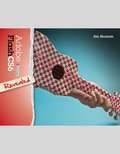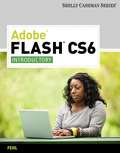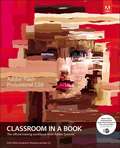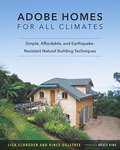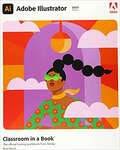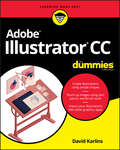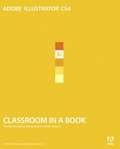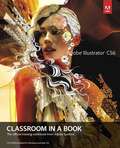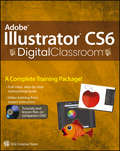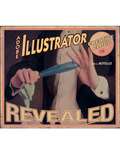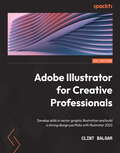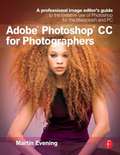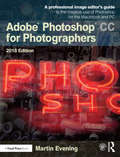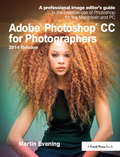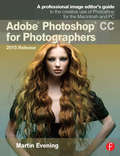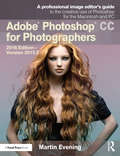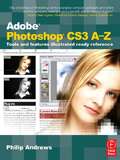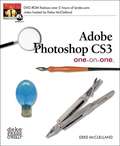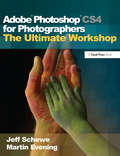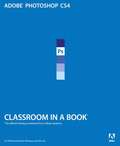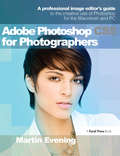- Table View
- List View
Adobe Flash CS4 Revealed
by Jim ShumanWith the much-anticipated arrival of Adobe Flash CS4 comes the opportunity to create even more exciting and effective interactive experiences and animations on the Web. And this innovative book will guide you through every step along the way. Adobe Flash CS4 Revealed provides a comprehensive yet concise introduction to the new Flash CS4 Professional. The book begins with a discussion of fundamental concepts, which provide a context for learning and set the stage for specific Flash skill development. A series of step-by-step tutorials follows, covering the range of basic to intermediate skills, including creating animations, using special effects, drawing objects, incorporating sound and video, and using ActionScript. These topics, along with coverage of the updated features of Flash CS4 Professional- such as enhancements to the workspace, importing Photoshop and Illustrator files, the Flash planning and workflow processes, and the Help feature-make this book an indispensable resource in the library of anyone who wants to take full advantage of Flash CS4.
Adobe Flash CS6: Creative Cloud Revealed Update
by James E. ShumanYour Adobe Creative Cloud package includes two components: 1) Online access to Adobe Creative Cloud updates on your CourseMate product, and 2) the CS6 edition of your Adobe book. CourseMate enriches your learning with thorough, chapter-by-chapter summaries of the new Adobe Creative Cloud release. Author-created video introductions cover each chapter's learning objectives, emphasizing their importance for the contemporary design professional. Flashcards, quizzes, and games are also included. Your printed book covers fundamental concepts, starting with the workspace and proceeding logically and intuitively to more advanced topics. Step-by-step tutorials and user-friendly design result in a resource that is comprehensive, clear, and effective. Contact your Learning Consultant to learn more about how CourseMate can enhance the way you teach and your students learn. The online Creative Cloud content updates are for the June 2013 release of Adobe Creative Cloud.
Adobe Flash CS6: Introductory
by Alec FehlADOBE FLASH CS6: COMPREHENSIVE, 1E follows the Shelly Cashman Series proven step-by-step, screen-by-screen approach to teaching the Adobe Flash CS6 software. The pedagogy of this text has been enhanced to reflect the learning styles of today's students. Readers will easily follow along with the chapters in the text to gain valuable and comprehensive software skills and take full advantage of the program.
Adobe Flash Professional Cs6 Classroom In A Book
by Adobe Creative Team StaffThose creative professionals seeking the fastest, easiest, most comprehensive way to learn Adobe Flash Professional CS6 choose Adobe Flash Professional CS6 Classroom in a Book from the Adobe Creative Team. The 10 project-based lessons in this book show readers step-by-step the key techniques for working in Flash CS6. Readers learn what they need to know to create engaging interactive content with Flash CS6. In addition to learning the key elements of the Flash interface, including panels, timelines, and frames, readers learn how to work with graphics, create and edit symbols, modify text, add interactivity with ActionScript, and incorporate animation and sound into their projects. They also learn how to prepare and export their finished projects for publishing. This completely revised CS6 edition shows readers how to generate sprite sheets for enhanced game development workflow and deliver apps with a prepackaged Adobe AIR captive runtime for better user experience. The book also covers the new, powerful, and intuitive tools and integrated support for reaching audiences across devices that run on Android and iOS platforms by targeting the Adobe AIR 3. 2 runtime. The companion DVD includes lesson files so readers can work along with the book, as well video training from Learn Adobe Flash Professional CS6 by Video. "The Classroom in a Book series is by far the best training material on the market. Everything you need to master the software is included: clear explanations of each lesson, step-by-step instructions, and the project files for the students. " --Barbara Binder, Adobe Certified Instructor, Rocky Mountain Training Classroom in a Book®, the best-selling series of hands-on software training workbooks, helps you learn the features of Adobe software quickly and easily. Classroom in a Book offers what no other book or training program does--an official training series from Adobe Systems Incorporated, developed with the support of Adobe product experts.
Adobe Homes for All Climates
by Lisa Schroder Vince OgletreeThe lay-up of adobe bricks is an easy, forgiving way to achieve a solid masonry-wall system. Contrary to stereotypes, adobe is perfectly adaptable for use in cold, wet climates as well as hot and dry ones, and for areas prone to earthquakes. With its efficient use of energy, natural resources for construction, and minimal effort for long-term maintenance, it's clear that the humble adobe brick is an ideal option for constructing eco-friendly structures throughout the world. The book is ideal both for first-time do-it-yourselfers and for experienced adobe builders seeking to improve their craft. Drawing on the experience of more than fifty major adobe projects since 1993,Adobe Homes for all Climatesdescribes Adobe Building Systems' patented reinforcement and scaffolding systems, showing readers how to construct adobe homes more easily and safely, and with superior strength, durability, structural integrity, and aesthetic appeal, as compared to earthen homes of the past. All aspects of adobe construction are covered, including making and laying adobe bricks, installing lintels and arches, conduits and pipes, doors and windows, top plates and bondbeams, ideal wall dimensions, adobe finishes, and other adobe construction components, such as the inexpensive use of scaffolding. These methods will produce a premium product that will meet and often exceed inspection standards. Equipped with this manual, you will be able to obtain a building permit, make adobe bricks swiftly, and confidently lay them up. You will be able to beautifully finish your adobe walls with earth plasters creating stunning colors and outstanding light effects and create a beautiful, energy-efficient home that will last for generations to come.
Adobe Illustrator (Classroom in a Book)
by Brian WoodThe fastest, easiest, most comprehensive way to learn Adobe Illustrator. <p><p> Classroom in a Book®, the best-selling series of hands-on software training workbooks, offers what no other book or training program does -- an official training series from Adobe, developed with the support of Adobe product experts. <p><p> Adobe Illustrator Classroom in a Book (2021 release) contains lessons that cover the basics and beyond, providing countless tips and techniques to help you become more productive with the program. You can follow the book from start to finish or choose only those lessons that interest you.
Adobe Illustrator CC For Dummies
by David KarlinsGet to know your digital drawing board Adobe Illustrator CC offers a vibrant tool for creating drawings and illustrations in a digital environment. It takes some practice to get a feel for the digital pens, pencils, paintbrushes, and erasers, though. Adobe Illustrator CC For Dummies offers the guidance you need to turn your ideas into real drawings. Written by an Illustrator trainer and expert, this book walks those new to the tool through the basics of drawing, editing, and applying the unique tools found in this popular program. Create illustrations using simple shapes Touch up images using pen, pencil, and brush tools Import your illustrations into other graphic apps Apply special effects and add type This book is essential reading for new and beginning illustrators who are either adopting a digital tool for the first time, switching from an existing tool to Illustrator, or adding Illustrator know-how to existing Adobe knowledge.
Adobe Illustrator CS4: Classroom in a Book
by Adobe SystemsThe fastest, easiest, most comprehensive way to learn Adobe Illustrator CS4 Adobe Illustrator CS4 Classroom in a Book contains 15 lessons. The book covers the basics of learning Illustrator and provides countless tips and techniques to help you become more productive with the program. You can follow the book from start to finish or choose only those lessons that interest you. Learn how to create artwork for illustrations, logos, stationery, page layouts, posters, and integrate with Adobe Flash movies, Adobe In Design layouts, and more! "The Classroom in a Book series is by far the best training material on the market. Everything you need to master the software is included: clear explanations of each lesson, step-by-step instructions, and the project files for the students. " -Barbara Binder, Adobe Certified Instructor, Rocky Mountain Training Classroom in a Book , the best-selling series of hands-on software training workbooks, helps you learn the features of Adobe software quickly and easily. Classroom in a Book offers what no other book or training program does-an official training series from Adobe Systems Incorporated, developed with the support of Adobe product experts.
Adobe Illustrator CS6 Classroom in a Book
by The Editors at the Adobe PressThis book is part of the official training series for Adobe graphics and publishing software developed with the support of Adobe product experts.
Adobe Illustrator CS6 Digital Classroom (Digital Classroom)
by Jennifer Smith AGI Creative TeamA highly accessible, step-by-step guide to Adobe Illustrator CS6 Illustrator CS6 Digital Classroom includes 12 self-paced lessons that contain essential skills and explore new features and capabilities of Adobe Illustrator. Every lesson is presented in full color with step-by-step instructions. Learning is reinforced with video tutorials and lesson files on a companion DVD that was developed by a team of expert instructors and Illustrator experts. Each video tutorial demonstrates and explains the concepts and features covered in the lesson. This training package shows how to create and produce vibrant graphics using this robust vector drawing application. Offers a complete training package combining a full-color, step-by-step instructional book with lesson files and video training from expert instructors Offers the basics for tapping into the power of Adobe Illustrator to create and produce brilliant art for all types of media Contains full-color, step-by-step instructions that make learning complicated tasks less intimidating Demonstrates how to quickly get up to speed using Illustrator to create sophisticated page layouts and work in a dynamic publishing environment Jam-packed with information, the book and DVD take you from the basics through intermediate level topics. You'll get the information you need in a clear, approachable manner. NOTE: DVD and other supplementary materials are not included as part of the e-book file, but are available for download after purchase.
Adobe Illustrator CS6 Revealed
by Chris BotelloADOBE ILLUSTRATOR CS6 REVEALED offers you comprehensive coverage in all areas of Adobe Illustrator. Beginning with fundamental concepts and progressing to in-depth exploration of the software's full set of features, these step-by-step lessons offer you a guided tour of all the program's great features - including an illustrated tutorial on "how to draw with the Pen tool" that you won't find in any other book. This new edition highlights extensive coverage of important and exciting new features, including dramatic improvements to Illustrator's built-in tracing utility and a major upgrade for creating patterns.
Adobe Illustrator Creative Cloud, Revealed (Stay Current With Adobe Creative Cloud Ser.)
by Chris BotelloNIMAC-sourced textbook
Adobe Illustrator for Creative Professionals: Develop skills in vector graphic illustration and build a strong design portfolio with Illustrator 2022
by Clint BalsarBuild your own designs using vector shapes and apply design principles when creating projects in Adobe Illustrator with the help of this full-color guideKey FeaturesApply industry trends and methods and move from concept to completion of designsManipulate tools within the software to make your creative process smootherMaster the technique of using tools such as the Shaper Tool, Shape Builder Tool, and the Live Paint BucketBook DescriptionAdobe Illustrator is a vector-based art tool for visual creatives. It is an industry-standard tool that helps you take a design from concept to completion, including the process of peer collaboration and client feedback.Complete with step-by-step explanations of essential concepts and practical examples, you'll begin to build confidence as you master the methods of successful illustrators in the industry by exploring crucial tools and techniques of Adobe Illustrator. You'll learn how to create objects using different tools and methods while assigning varied attributes and appearances. Throughout the book, you'll strengthen your skills in developing structures for maintaining organization as your illustration grows.By the end of this Adobe Illustrator book, you'll have gained the confidence you need to not only create content in the desired format and for the right audience but also build eye-catching vector art based on solid design principles.What you will learnMaster a wide variety of methods for developing objectsControl files using layers and groupsEnhance content using data-supported infographicsUse multiple artboards for better efficiency and asset managementUnderstand the use of layers and objects in IllustratorBuild professional systems for final presentation to clientsWho this book is forThis book is for creative illustrators with basic to intermediate-level experience with vector-based software who want to take their existing skills to the next level. Prior knowledge of vector-based illustration concepts will help you get the most out of this Adobe Illustrator software book and produce impressive results.
Adobe Photoshop CC for Photographers
by Martin EveningMartin Evening, Photoshop hall-of-famer and acclaimed digital imaging professional, has revamped his much-admired Photoshop for Photographers book for an eleventh edition, to include detailed instruction for all of the updates to Photoshop CC on Adobe's Creative Cloud. This comprehensive guide covers all the tools and techniques serious photographers need to know when using Photoshop, from workflow guidance to core skills to advanced techniques for professional results. Using clear, succinct instruction and real world examples, this guide is the essential reference for Photoshop users of all levels. Accompanying the book is the photoshopforphotographers.com website, fully updated with new sample images, new tutorial videos, and additional bonus chapters. It's clear why so many people feel that any serious Photoshop user should not be without this invaluable reference text.
Adobe Photoshop CC for Photographers 2018: A Professional Image Editor's Guide To The Creative Use Of Photoshop For The Macintosh And Pc
by Martin EveningAdobe Photoshop CC for Photographers by acclaimed digital imaging professional Martin Evening has been revamped to include detailed instruction for all of the updates to Photoshop CC on Adobe’s Creative Cloud, including significant new features, such as the painting tool and Pen path tool refinements and Range Masking in Camera Raw. This guide covers all the tools and techniques photographers and professional image editors need to know when using Photoshop, from workflow guidance to core skills to advanced techniques for professional results. Using clear, succinct instruction and real world examples, this guide is the essential reference for Photoshop users. The accompanying website has been updated with new sample images, tutorial videos, and bonus chapters.
Adobe Photoshop CC for Photographers, 2014 Release: A professional image editor's guide to the creative use of Photoshop for the Macintosh and PC
by Martin EveningAdobe Photoshop for Photographers 2014 Release by Photoshop hall-of-famer and acclaimed digital imaging professional Martin Evening has been fully updated to include detailed instruction for all of the updates to Photoshop CC 2014 on Adobe’s Creative Cloud, including significant new features, such as Focus Area selections, enhanced Content-Aware filling, and new Spin and Path blur gallery effects. This guide covers all the tools and techniques photographers and professional image editors need to know when using Photoshop, from workflow guidance to core skills to advanced techniques for professional results. Using clear, succinct instruction and real world examples, this guide is the essential reference for Photoshop users of all levels. Accompanying the book is the photoshopforphotographers.com website, with sample images, tutorial videos, and bonus chapters.
Adobe Photoshop CC for Photographers, 2015 Release: 2015 Release
by Martin EveningAdobe Photoshop CC for Photographers by Photoshop hall-of-famer and acclaimed digital imaging professional Martin Evening has been revamped for a thirteenth edition to include detailed instruction for all of the updates to Photoshop CC on Adobe’s Creative Cloud, including significant new features, such as faster Camera Raw processing, Blur Gallery noise matching, and new export options for quick image-saving and layers as separate documents. This guide covers all the tools and techniques photographers and professional image editors need to know when using Photoshop CC, from workflow guidance to core skills to advanced techniques for professional results. Using clear, succinct instruction and real world examples, this guide is the essential reference for Photoshop users. Accompanying the book is the photoshopforphotographers.com website, fully updated with new sample images, tutorial videos, and bonus chapters.
Adobe Photoshop CC for Photographers: 2016 Edition — Version 2015.5
by Martin EveningAdobe Photoshop CC for Photographers by Photoshop hall-of-famer and acclaimed digital imaging professional Martin Evening has been revamped to include detailed instruction for all of the updates to Photoshop CC on Adobe’s Creative Cloud, including significant new features, such as Select and Mask editing, Facial Liquify adjustments and Guided Upright corrections in Camera Raw. This guide covers all the tools and techniques photographers and professional image editors need to know when using Photoshop, from workflow guidance to core skills to advanced techniques for professional results. Using clear, succinct instruction and real world examples, this guide is the essential reference for Photoshop users. The accompanying website has been updated with new sample images, tutorial videos, bonus chapters, and a chapter on the changes in Photoshop 2017.
Adobe Photoshop CS3 A-Z: Tools and features illustrated ready reference
by Philip AndrewsFind solutions quick with this accessible encyclopedic guide. Conveniently organized in a clear A-Z format, this illustrated ready reference covers every action you are likely to make as a photographer. You'll never want it far from your side while you work with Photoshop.* Covers all of Photoshop's mass of tools concisely in an intuitive, colorful layout * New section shows you fast solutions for everyday editing tasks: step-by-step tutorials illustrate how to conquer key tasks and techniques * Fully updated for CS3 * Includes all versions of Photoshop-shortcut keys specify which version of Photoshop is applicableThis visual resource is the ideal companion to every Photoshop book on your shelf. Associate website www.Photoshop-A-Z.com features matching video tutorials for each step-by-step tutorial.For Photoshop users at all levels-covers everything from the everyday to the hidden features you need in a pinch.Dodge the frustrations that can come with time-sensitive, quality work with Philip Andrews. Philip is a professional photographer, digital photography teacher, magazine editor, and best-selling international author. Filled with practical advice from one photographer to another, Philip uses his trademark straight-talking style to ensure that everyone can get to grips with all the features of CS3 quickly and confidently."Beyond just delivering accurate information, Philip books are always up to date and very enjoyable to read. Philip's tutorials deliver to you an easy, approachable style rarely found in software instruction...an extremely valuable reference"Bryan O'Neil Hughes, Photoshop Product Manager, Adobe Systems Inc.On previous editions:"If you ever wanted a quick reference guide to the mass of tools in Photoshop, then this is the answer...Keep it to hand as a quick and easy guide." - Which Digital Camera "Each section is expressed clearly with simple buy highly effective and user-friendly illustrations... you should definitely have to hand while working at your computer." - Amateur Photographer
Adobe Photoshop CS3 One-on-One
by Deke McclellandPioneering computer graphics author Deke McClelland updates his bestselling hands-on tutorial for Adobe Photoshop CS3, the latest version of this industry-standard image editing and production program. As with previous editions, Photoshop CS3 One-on-One guides readers step by step through the program's features and functionality. A key appeal of the One-on-One series is the two hours of DVD-video material included. Once you read about a particular technique, you can see how it's done first hand in the video. The combination is uniquely effective. And hugely popular. Whether you're a first-timer looking to learn Photoshop, or a seasoned user interested in the groundbreaking features of CS3, Deke's conversational style and carefully structured lessons guide you through everything you need to know to get up and running, and then takes you well into mastery. You'll learn to: Grasp fundamental and advanced concepts and theory Use best practices, and techniques for making the most of Photoshop CS3 Build relevant, real-world projects Use Photoshop's workflow and file handling features Use the combined power of Bridge + Camera Raw to process your digital photos Choose the right technique for converting your images to black & white Create beautiful multilayered documents including posters and flyers And much more A Photoshop expert, sought-after computer graphics and design lecturer and author of over 70 books, Deke creates a classroom environment in Photoshop CS3 One-on-One with written instruction and video training -- except that you get one-on-one attention as you proceed from lesson to lesson at your own pace. It's like having private lessons with the author. Whether you're an enthusiast, prosumer, creative pro, technical pro, or newcomer, Deke's book will have you speaking fluent Photoshop CS3 in no time.
Adobe Photoshop CS4 Revealed
by Elizabeth Eisner RedingDiscover all that Adobe Photoshop CS4 has to offer! With detailed attention to artistic and technical features alike, Adobe Photoshop CS4 Revealed provides a solid foundation for those looking to learn this industry-standard program. Real-world, practical examples and step-by-step instruction throughout offer well-rounded, comprehensive coverage. With extensive four-color artwork and screenshots that support and clarify key concepts, Adobe Photoshop CS4 Revealed is a valuable resource that will give readers the confidence they need to edit images with skill and ease using Photoshop CS4.
Adobe Photoshop CS4 for Photographers: The Ultimate Workshop
by Martin Evening Jeff ScheweProfessional commercial photographer and digital imager Jeff Schewe (based in Chicago, USA) has teamed up with best-selling Photoshop author Martin Evening to provide advanced Photoshop users with never before seen tips and techniques.Building on Martin Evening's successful Adobe Photoshop for Photographers series of titles, this new guide takes Photoshop users to further depths exploring the power of Photoshop CSX. Highly visual, with clear, step-by-step tutorials, this advanced guide will appeal to those who want to take Photoshop beyond the boundaries.
Adobe Photoshop CS4: Classroom in a Book
by Adobe SystemsThe fastest, easiest, most comprehensive way to learn Adobe Photoshop CS4 Fourteen lessons in Adobe Photoshop CS4 Classroom in a Book cover basic and advanced techniques in Adobe Photoshop, the world's best image-editing software. Learn how to retouch digital photos, work with layers and masks, navigate the workspace, prepare images print, and explore the latest features. Tips, extra-credit exercises, and step-by-step lessons help you become more productive using Photoshop. Learn to correct and enhance digital photos, create image composites, transform images in perspective, and prepare images for print and the web. Combine images for extended depth of field, and try out the new 3D features in Adobe Photoshop CS4 Extended. "The Classroom in a Book series is by far the best training material on the market. Everything you need to master the software is included: clear explanations of each lesson, step-by-step instructions, and the project files for the students. " -Barbara Binder, Adobe Certified Instructor, Rocky Mountain Training Classroom in a Book , the best-selling series of hands-on software training workbooks, helps you learn the features of Adobe software quickly and easily. Classroom in a Book offers what no other book or training program does-an official training series from Adobe Systems Incorporated, developed with the support of Adobe product experts.
Adobe Photoshop CS5 Revealed
by Elizabeth Eisner RedingDiscover all that Adobe Photoshop CS5 has to offer! With detailed attention to artistic and technical features alike, ADOBE PHOTOSHOP CS5 REVEALED provides a solid foundation for those looking to learn this industry-standard program. Real-world, practical examples and step-by-step instruction throughout offer well-rounded, comprehensive coverage. With extensive four-color artwork and screenshots that support and clarify key concepts, ADOBE PHOTOSHOP CS5 REVEALED is a valuable resource that will give readers the confidence they need to edit images with skill and ease using Photoshop CS5.
Adobe Photoshop CS5 for Photographers: A professional image editor's guide to the creative use of Photoshop for the Macintosh and PC
by Martin EveningWith the new edition of this proven bestseller, Photoshop users can master the power of Photoshop CS5 with internationally renowned photographer and Photoshop hall-of-famer Martin Evening by their side. In this acclaimed reference work, Martin covers everything from the core aspects of working in Photoshop to advanced techniques for professional results. Subjects covered include organizing a digital workflow, improving creativity, output, automating Photoshop, and using Camera RAW. The style of the book is extremely clear, with real examples, diagrams, illustrations, and step-by-step explanations supporting the text throughout. This is, quite simply, the essential reference for photographers of all levels using Photoshop. All DVD content is now available online at www.focalpress.com/cw/evening-9780240522005/ for kindle and eBook readers.

